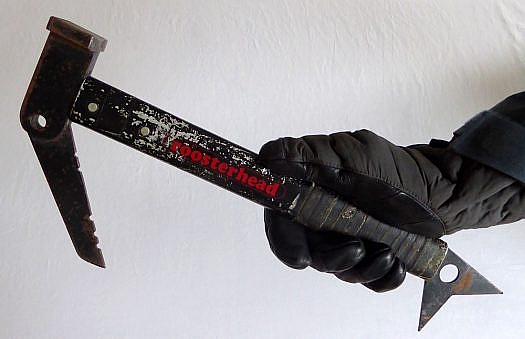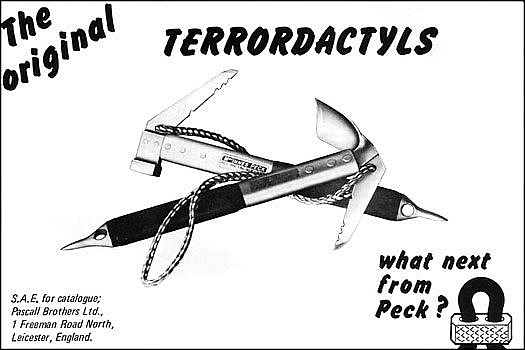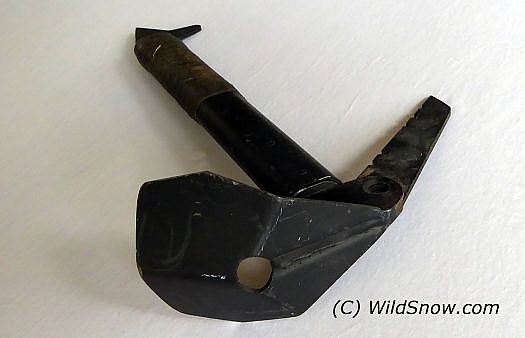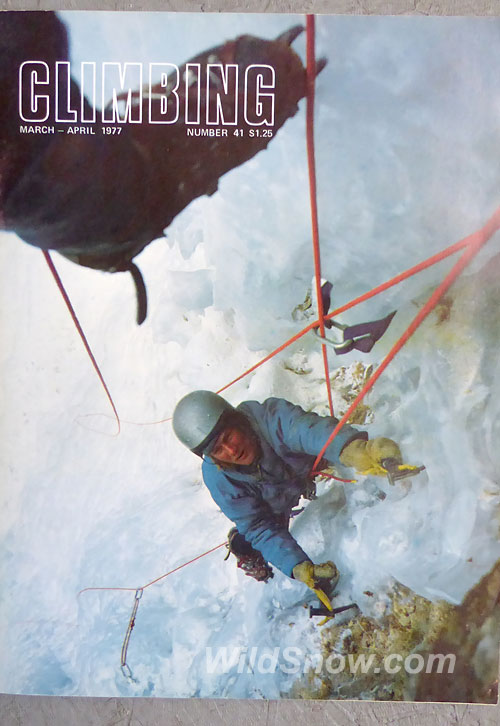Two Roo’ and I Can Climb Anything
With nearly any sport, gear often drives or at least supports the progression of achievement. In the case of ice climbing, the overarching development of the past fifty years was clearly the advent of “drop” or “droop” pick hand-tools.

Peter Hutter’s fine Rooster Head ice climbing tool, introduced 1972.
From about 1969 on, Hamish MacInnes and Derek Gamble of the Peck U.K climbing gear company, as well as other tool companies such as Chouinard and Grivel, turned their attention to making droop pick ice climbing versions of the venerable ice ax, with the pick angle being steep enough for purchase on vertical ice (too little angle results in the tool easily coming out backwards when you’re attempting to hang on it, as well as your center of gravity being too high).
The resulting implement, which Peck called the “Terrordactyl,” revolutionized ice tool design. Nothing as radical existed when the Terror’ was released into retail, dedicated to the steeps, intended as a hand tool with a stubby hand shaft. While the Terro was reasonably well made, the pick bent easily and the overall balance and weight were slightly off the ideal. More, the straight shaft often drove your knuckles into the ice when you swung for a pick plant. The results were reminiscent of bare knuckle prize fighting.
Colorado in those days was a hotbed of vertical waterfall ice climbing. Jeff Lowe, Duncan Ferguson, Pete Athens and others of their Front Range gang were constantly grabbing new routes. Myself, Steve Shea, Michael Kennedy, Larry Bruce and others from the Colorado Western Slope were doing the same.
An Aspen based engineer, Peter Hutter, ice climbed with the our Aspen crew. He experienced the Terrordactyl, and immediately realized it could be improved: stronger, slightly heavier, better balanced, and with knuckle protection.
Using his engineering chops, Hutter set about designing a tool he called the Rooster Head. The “Roo” began retail around 1973. It was similar to the “Terror” in appearance, but the twinning stopped there. As soon as any ice climber swung a Rooster Head, they enjoyed a significant reduction in knuckle bashing due to the “Roo” possessing a forward facing steel tab at the base of the shaft, intended to encounter the ice before your bone structure impacted (as well as stabilizing the tool from rotation). Along with that, the Rooster simply felt more solid — more like a “tool.”
Among our Central Colorado crowd, the Rooster Head became the vertical ice weapon of choice. You felt invincible, standing in your crampons at the base of a frozen waterfall, a Rooster in each hand, gladiator at the ready. Our mantra was “Two Roo’ and I can climb anything.”

The Peck tool that Peter based the Rooster Head on. While the Rooster was similar in appearance, it was noticeably different in performance. Myself, Shea and Kennedy all used both brands at one time or another and easily favored the Roo’, so this was not mere theory. I recently asked Hutter if there were any issues with the Rooster being similar in appearance to the Terror. He said there were never any problems, due to the concept of the droop pick having become somewhat common by 1972.
Terrordactyls and Rooster Heads would travel worldwide, helping make new routes, changing ice climbing forever.
The angled and dropped pick concept of continued to revolutionize alpinism. Ice tools eventually evolved to aesthetically swooping pick angles that “hooked” ice and tiny holds on dry rock with equal aplomb, e.g., “mixed” climbing. Both the Terrordactyl and Rooster Head had big parts in that. Gear driving sport, or at the least doing a good job of helping fight gravity.

Hutter made an adz model of the Rooster as well. This was a beautiful tool, more useful for firmer snow climates than Colorado, but I occasionally wished I’d had one. Normally, I preferred two hammer models.

Climbing Magazine March-April 1977. Your friendly blogger on the cover. At the time, _Climbing_ was beginning to break out of being overly regional (this issue has a Peter Habeler article, for example), but us local boys got attention since we all climbed with the editor, Michael Kennedy. No problem, the magazine coverage had a lot to do with my six figure ice climbing sponsorship (smile). This is a 1976 shot Kennedy got on Hidden Falls in Glenwood Canyon, both of us choking two Roosters. I’m not sure what’s with all the rope, I think we had someone else coming up and left some pro in for them, along with me bringing their rope up.
Comments
2 Responses to “Two Roo’ and I Can Climb Anything”


I still have my Roosterhead hammer. I wish I had a second one. I carry it as my third tool now.
Mugs Stump had a Roosterhead hammer with him on the 1st ascent of the East face of the Mooses Tooth.